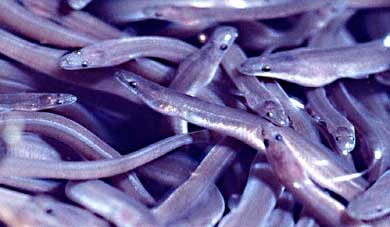There are two really interesting papers this week on migration; one of which looks at eels. Eels are a hot topic because, as well being the thing that you put in jellied eels and which many people find very, very tasty, eels are in decline. Their numbers have gone down enormously in recent years and they're actually an animal which we know very little about but they make huge migrations across the oceans. They go 5,000 kilometres from Europe, all the way across to the North Atlantic to a place called the Sargasso Sea, which is where they mate and reproduce. If we are to try and conserve this species, we need to understand how they do that, how they make this journey and what the parameters of that journey are. Because if we don't understand anything the species, how can we save them?
 Unfortunately there are problems with tracking a fish which swims about underwater, sometimes a thousand metres underwater.
Unfortunately there are problems with tracking a fish which swims about underwater, sometimes a thousand metres underwater.
A group of researchers at the Technical University of Denmark: Kim Aarenstrup and her colleagues have a paper in Science this week. They've built very small satellite transceivers which they can put onto the eels. They released 22 eels in the West Coast of Ireland and let them swim off in November 2006. Every time these eels surfaced, the satellite transceivers would upload data on where the eel was, its position, where it had been in the water column and details about water environment that it was experiencing on its way.
They then reconstructed some of the eels' journeys to a distance of about 1,300 kilometres: a quarter of the way towards the Sargasso Sea.
And now we have some of our first insights into how they do this. The really interesting part is that these eels, after they depart, travel about 25 kilometres a day. But the researchers say that's actually too slow to get where they need to go by April, which is when they need to go to Sargasso Sea to mate.
So what are they doing?
The researchers suggest that what they do is swim down to Africa and then hitch a ride on a fast-moving ocean current which helps them to speed up and get the rest of the way much more quickly.
But one of the really intriguing bits of data was that the eels change their height in the water column between day and night. So during the daytime, they swim much deeper. They go down to about a thousand metres and at night time, they come up close to the surface.
Now, lots of animals do this because they come up at night time to warmer water to feed. But eels don't eat anything on their way to Sargasso Sea.
So why are they doing it?
The researchers think the warmer water closer to the surface is bad news because it speeds up the eels' metabolism and it makes them mature faster - because they need to make sure they're reaching sexual maturity when they reach the Sargasso Sea to mate. So by swimming along most of the time at deeper water and therefore lower temperatures they're actually slowing down their development and this means that they're in a position to be just in the right place, at the right stage of development. So when they get to the Sargasso Sea, they can mate. So it's an intriguing bit of research.










Comments
Add a comment